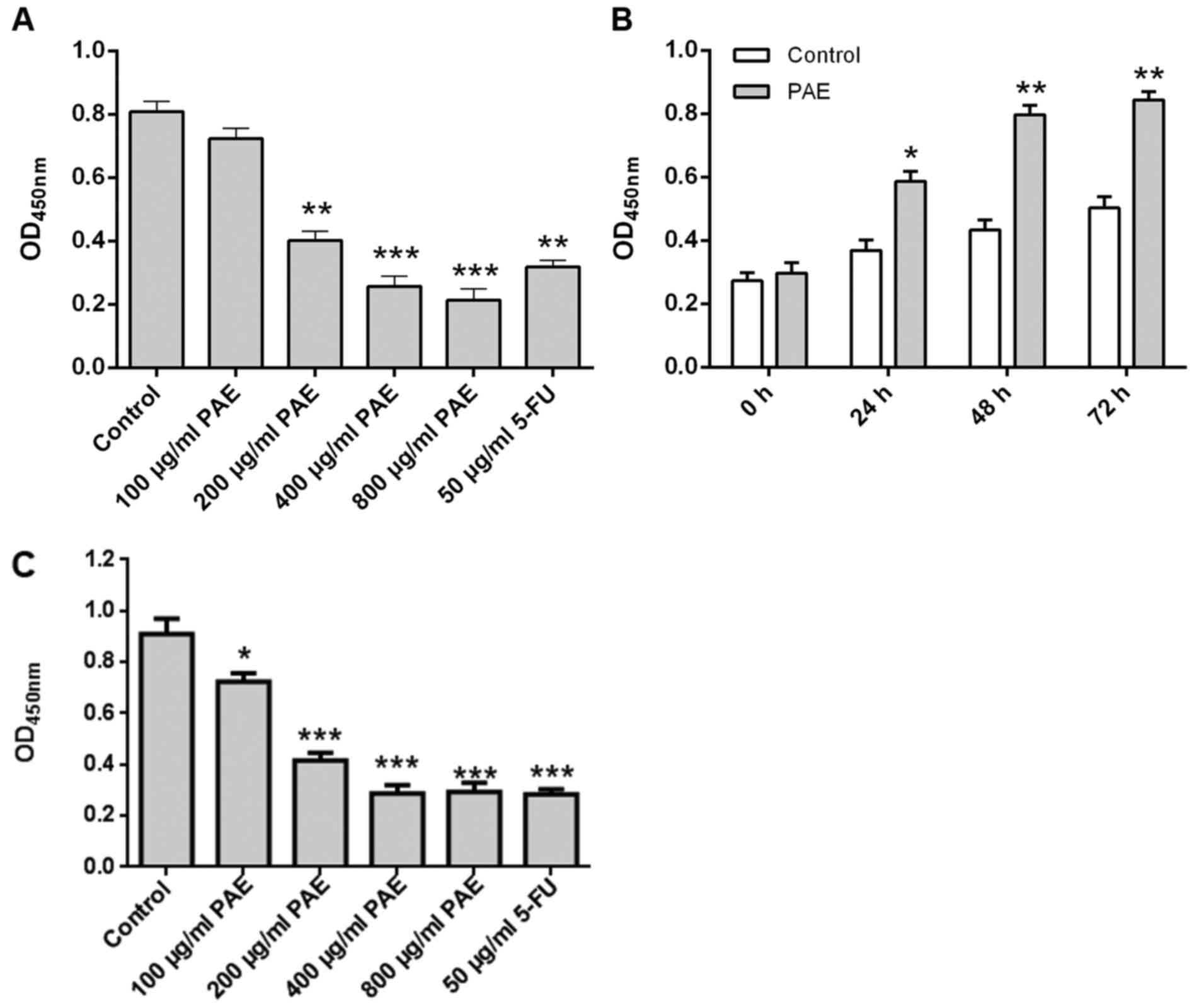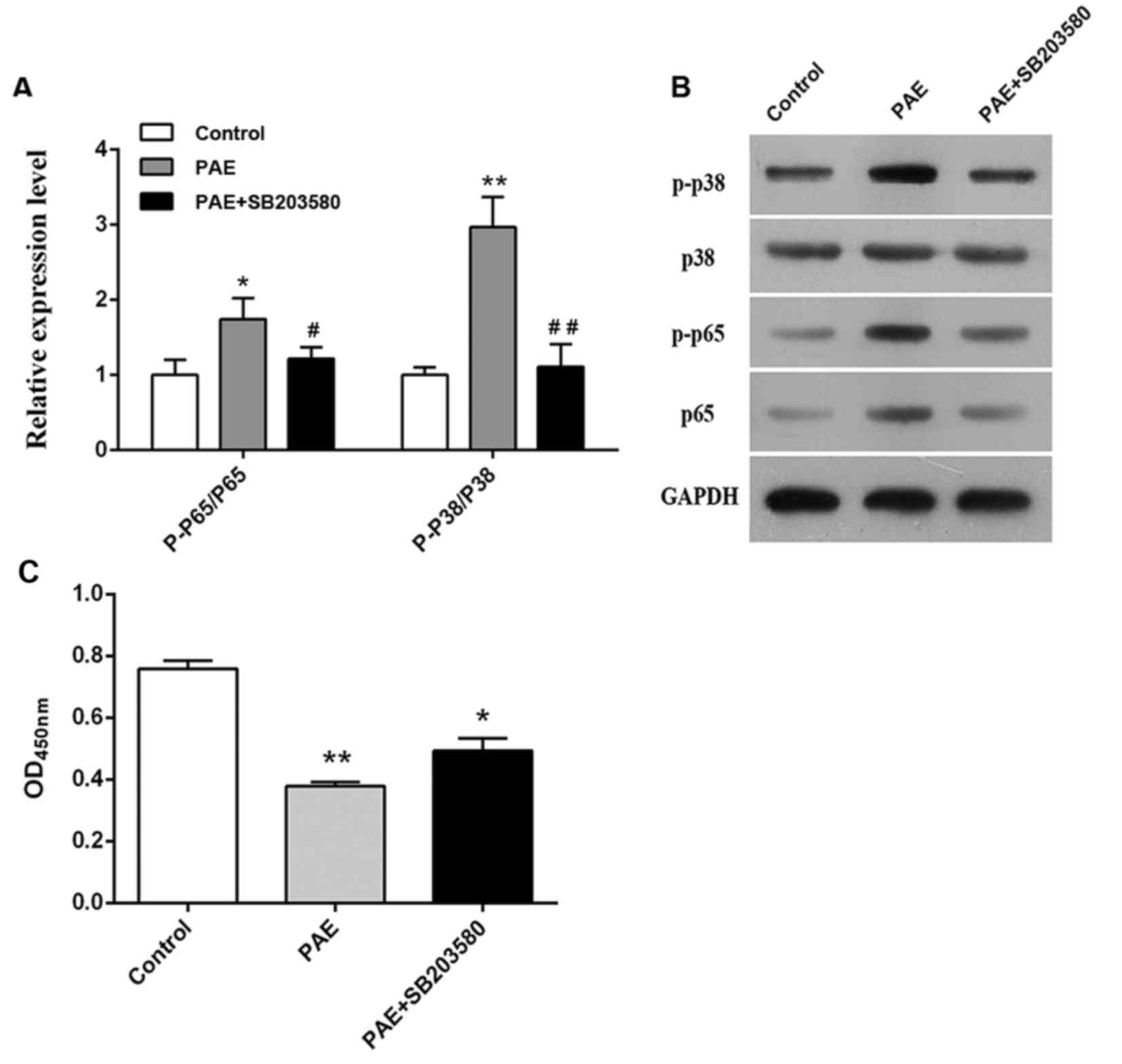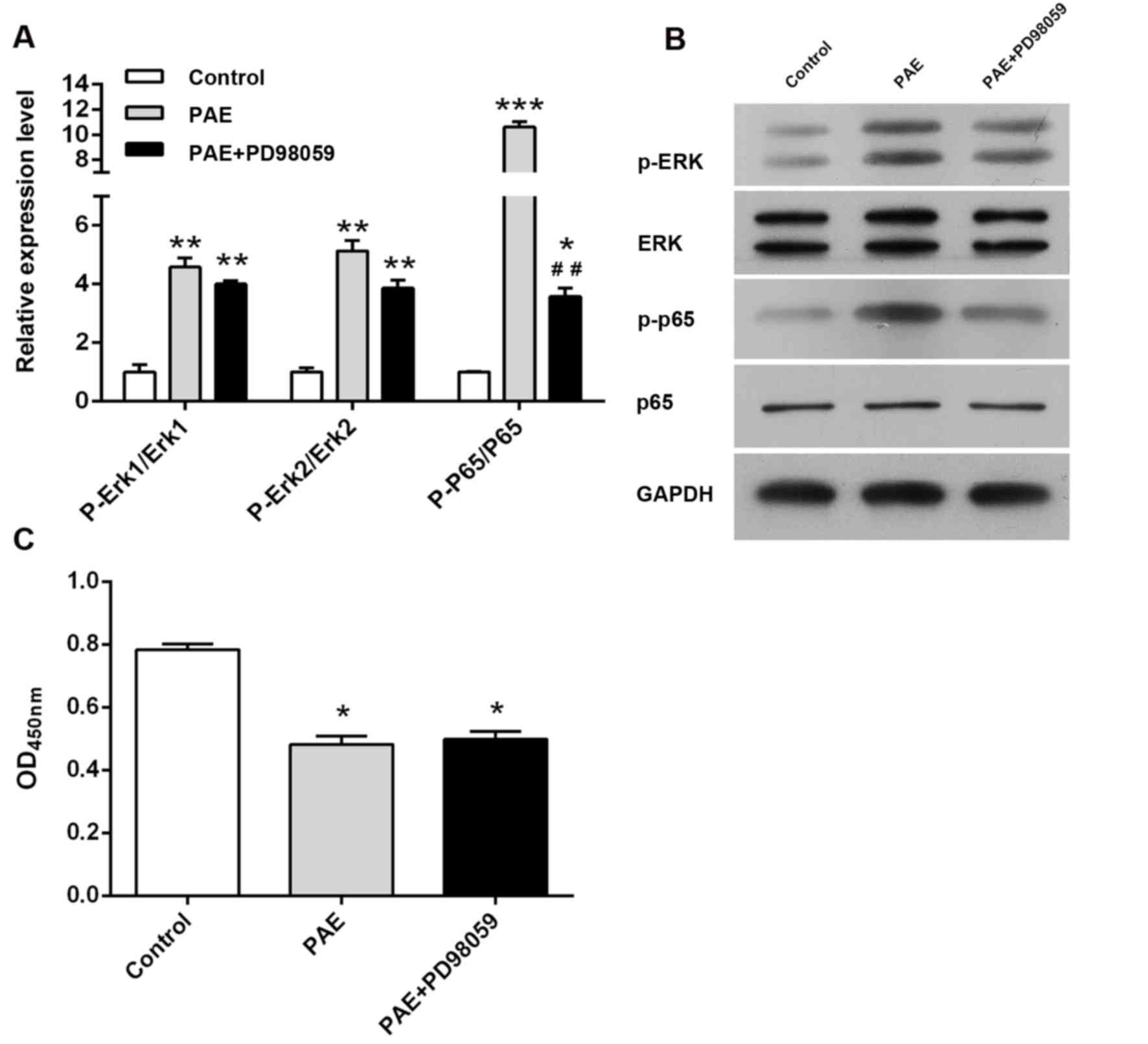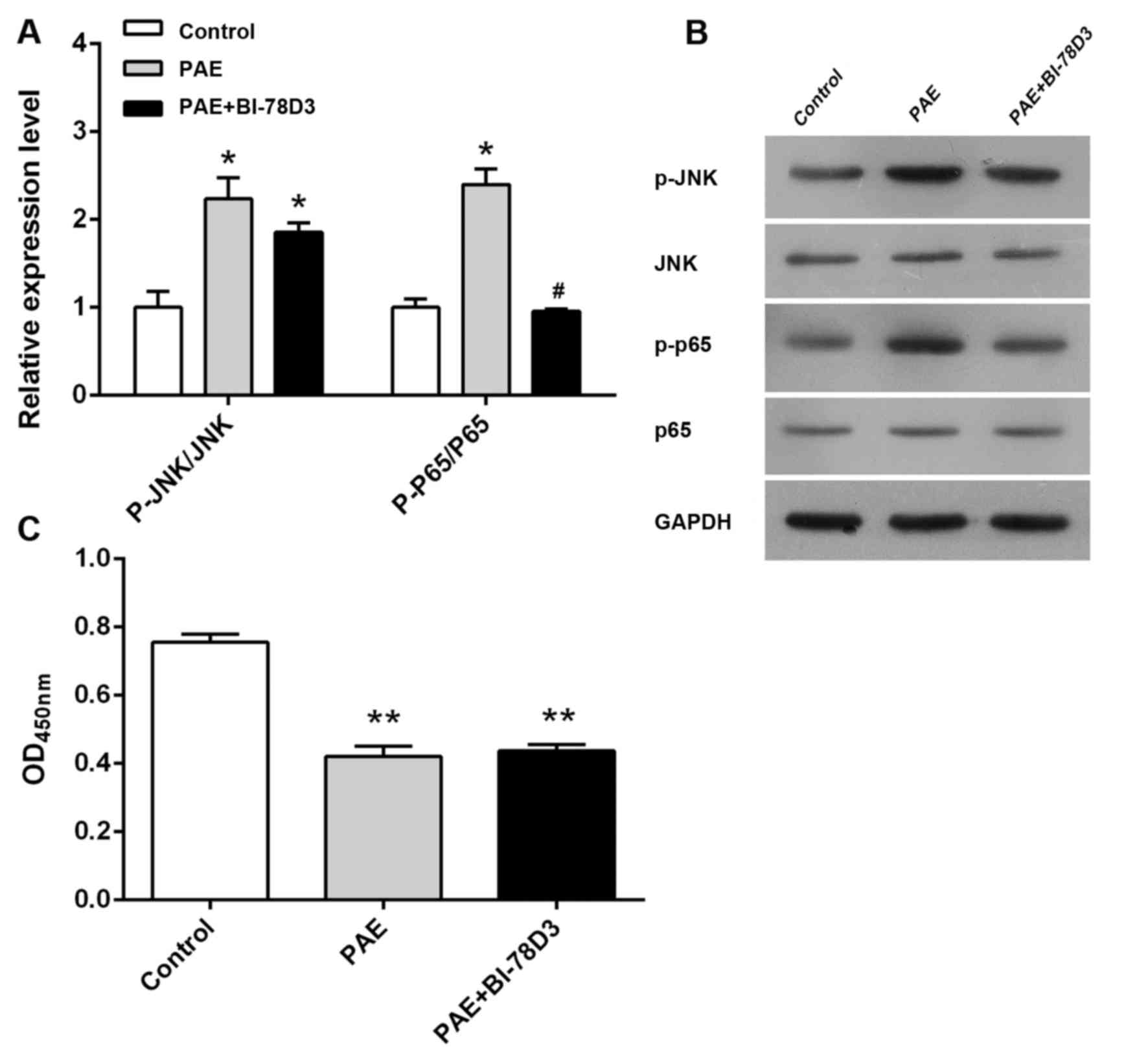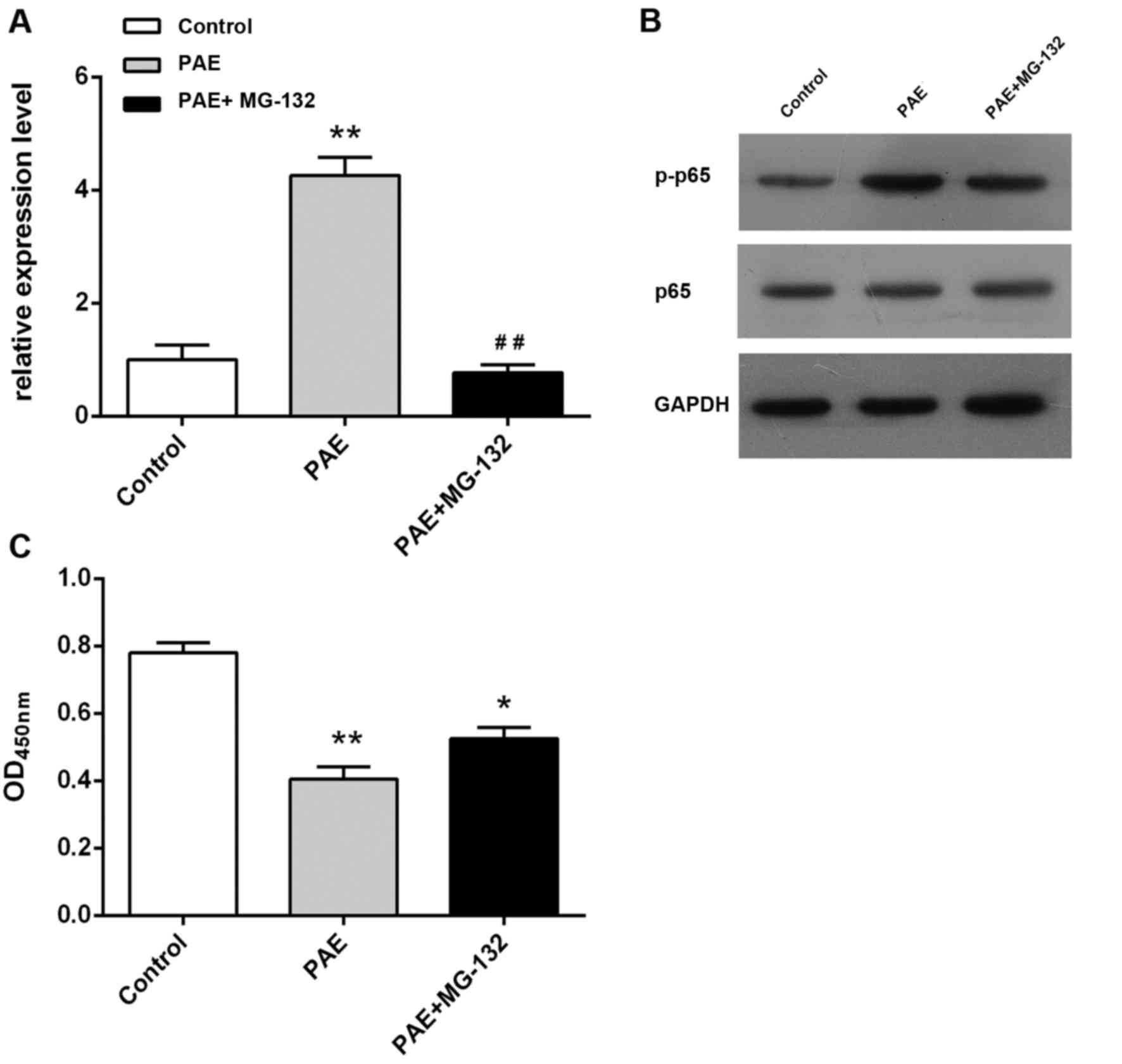Paeoniflorin inhibits proliferation of endometrial cancer cells via activating MAPK and NF‑κB signaling pathways
- Authors:
- Published online on: October 2, 2017 https://doi.org/10.3892/etm.2017.5250
- Pages: 5445-5451
-
Copyright: © Zhang et al. This is an open access article distributed under the terms of Creative Commons Attribution License.
Abstract
Introduction
In western countries, endometrial cancer is well known as one of the most common gynecological cancers and in Asian countries, the morbidity has been increasing (1). The incidence of endometrial cancer has had annual increases of 1.9% among women ≥50 years and 1.3% among women <50 years of age. The mortality has been multiplying by 1.1% per year and for 2017, ~10,585 deaths are anticipated (2). At present, the primary standard treatment for endometrial cancer is surgery. Chemotherapy, radiation therapy or their combination is chosen for patients with a medium or high recurrence risk. Most endometrial cancer patients were diagnosed in the early stage and treated with surgery alone or with additional radiation therapy (3). However, a significant proportion of endometrial cancer patients with metastasis or in the advanced stage still require systematic chemotherapy (4,5). Taxanes, platinum and adriamycin alone or in combination are currently used for recurrent or progressing endometrial cancer patients. The response rate of adriamycin and cisplatin combination in advanced endometrial carcinoma patients is up to 42% (6). However, the search for effective agents against either recurrent or advanced endometrial cancer remains disappointing (7). Accordingly, the development of novel compounds against endometrial cancer has attracted great attention and continuous research efforts are being made towards this goal. However, only a small number of studies on novel compounds with activity against endometrial cancer are currently available and the mechanisms remain largely elusive.
Novel antitumor agents derived and identified from natural sources have attracted exponential interest. The compounds represent a key alternative for the improvement of existing standard cancer therapies (8,9). Paeoniflorin (PAE) is a principal bioactive component of the root of Paeonia lactiflora Pall., a medicinal herb species found in Korea, Japan and China (10). In Traditional Chinese Medicine, PAE has been widely used (11). It has been reported that PAE exerts numerous pharmacological effects, such as anti-inflammatory (12,13), anti-allergy (14,15), immunoregulatory (16,17), neuroprotective (18) and hepatoprotective effects (19). Recent studies have suggested that PAE may be a novel potential antitumor agent. PAE inhibits the proliferation of a variety of human cancer cell types, including gastric carcinoma (10,11), lung cancer (19) and hepatocellular carcinoma cells (20). PAE was reported to induce cell cycle arrest via activating p53/14-3-3 zeta in HT29 colorectal cancer cells (21) and to promote apoptosis by downregulating matrix metalloproteinase-9 and upregulating microRNA-16 in human glioma cells (22). However, the anti-cancer effects of PAE on endometrial cancer have remained indeterminate.
In the present study, RL95-2 human endometrial cancer cells were selected to investigate the potential effect of PAE on the inhibition of cell proliferation. In addition, changes of protein expression in the mitogen-activated protein kinases (MAPKs) and nuclear factor-κB (NF-κB) signaling pathways as underlying mechanisms of PAE-mediated antitumor activity were studied. According to these attributes, PAE may be a promising novel candidate compound for the treatment of endometrial cancer.
Materials and methods
Reagents
Paeoniflorin (purity, ≥98%) and 5-fluorouracil (5-FU) were obtained from Aladdin Biochem Technology Co., Ltd. (Shanghai, China). Cell Signaling Technology, Inc. (Beverly, MA, USA) supplied the inhibitors SB203580, PD98059 and MG-132. Wuxi Jinpu Bio-Technology Co., Ltd. (Jiangsu, China) provided the inhibitor BI-78D3. The Cell Counting Kit-8 (CCK-8) was obtained from Dojindo Laboratories (Kumamoto, Japan).
Cell culture
The Cell Bank of the Chinese Academy of Sciences (Shanghai, China) supplied the RL95-2 human endometrial carcinoma cell line, and the HECCL-1 human endometrial carcinoma cell line was purchased from BeNa Culture Collection (Suzhou, China). Cells were cultured in Dulbecco's modified Eagle's medium/F12 (HyClone; GE Healthcare, Little Chalfont, UK) with 10% fetal bovine serum (Gibco; Thermo Fisher Scientific, Inc., Waltham, MA, USA), 100 µg/ml streptomycin and 100 U/ml penicillin (Beyotime Institute of Biotechnology, Inc., Haimen, China) at 37°C in a humidified atmosphere containing 5% CO2. A total of 2 h prior to the penicillin process, 50 µM SB203580, PD98059, BI-78D3 and MG-132 (Sigma-Alrich; Merck KGaA; Darmstadt, Germany) were pre-incubated with RL95-2 for 1 h at room temperature.
Cell proliferation assay
RL95-2 cells were seeded into 96-well plates at 1×104 cells/well and treated for the assigned times with either vehicle (0.1% dimethyl sulfoxide) or PAE at the indicated concentrations. The CCK-8 assay was performed to assess cell proliferation according to the manufacturer's instructions. The numerical absorption values obtained with an ELISA plate reader (Thermo Fisher Scientific, Inc.) at a wavelength of 450 nm were used to evaluate the cell viability.
Western blot analysis
RL95-2 cells were treated and the lysate was prepared as described previously (23). The protein (20 µg) was separated by 10% SDS-PAGE and transferred onto polyvinylidene difluoride membranes (EMD Millipore; Billerica, MA, USA). Immunoblots were exposed to primary antibodies at room temperature for 1 h. Antibodies used were against p38 (9212; 1:2,000 dilution), phosphorylated (p)-p38 (4511l 1:1,000 dilution), NF-κB p65 (8242l 1:1,500 dilution), p-p65 (3033l 1:2,000 dilution), extracellular signal-regulated kinase (ERK; 4695; 1:1,000 dilution), p-ERK (4370l 1:1,500 dilution) (all from Cell Signaling Technology, Inc.), c-Jun N-terminal kinase (JNK; ab179461; 1:1,000 dilution) or p-JNK (ab76572; 1:1,500 dilution) (all from Abcam, Cambridge, MA, USA). Subsequently, blots were incubated at room temperature for 40 min with horseradish peroxiase-conjugated secondary antibodies (BA1054; 1:20,000 dilution; Boster Biological Technology, Wuhan, China). The bands with immunoreactive proteins on the membrane were assessed by the ECL Plus Western Blotting Detection system (EMD Millipore). GAPDH was selected as the reference protein (kC-5G5; 1:10,000 dilution; Kangchen Biotech Co., Ltd., Shanghai, China).
Statistical analysis
Data analysis was performed using SPSS software (version 22.0; IBM Corp., Armonk, NY, USA). All values are expressed as the mean ± standard deviation. Student's t-test was applied to assess differences between two samples. Multiple comparison tests were performed via one-way analysis of variance. P<0.05 was considered to indicate a statistically significant difference.
Results
PAE inhibits human endometrial cancer cell proliferation
The effect of PAE on human endometrial cancer cell proliferation was initially assessed in RL95-2 cells. As depicted in Fig. 1A, PAE treatment at 100, 200, 400 and 800 µg/ml for 24 h resulted in a marked inhibition of proliferation in a dose-dependent manner. 400 µg/ml PAE exerted significant anti-proliferative activity (P<0.001) and was chosen to assess the role of time in PAE-induced proliferative inhibition. As displayed in Fig. 1B, treatment with 400 µg/ml PAE for 24, 48 and 72 h inhibited cell proliferation in a time-dependent manner. Similar results were obtained in anther endometrial cancer cell line, HECCL-1 (Fig. 1C).
Roles of MAPK signaling pathways in PAE-induced proliferative inhibition
Role of p38 MAPK in PAE-induced proliferative inhibitionFollowing vehicle or PAE treatment of RL95-2 cells for 24 h, the levels of p38, p-p38, p65 and p-p65 were detected by western blot analysis. PAE significantly upregulated p-p65 and p-p38 ratio (P<0.05, P<0.01; Fig. 2A and B), suggesting that PAE activated the p38 MAPK signaling pathway in RL95-2 cells. To clarify the role p38 MAPK activation in PAE-mediated proliferative inhibition, the p38 MAPK inhibitor SB203580 was added. Addition of SB203580 abolished the increase in p-p65 and p-p38 and prevented the proliferative inhibition induced by PAE (P<0.01; Fig. 2C). These findings suggested that the p38 MAPK signaling pathway may have an important role in the anti-proliferative effect of PAE on RL95-2 cells.
Role of ERK in PAE-induced proliferative inhibitionNext, the effect of ERK in the proliferative inhibition induced by PAE was evaluated. As depicted in Fig. 3A and B, PAE treatment caused a significant increase of p-ERK and p-p65 levels, which was significantly inhibited by ERK inhibitor PD98059. However, in the proliferation assay, pre-treatment with PD98059 did not affect the PAE-induced proliferative inhibition (P>0.05; Fig. 3C).
Role of JNK in PAE-induced proliferative inhibitionAs illustrated in Fig. 4, PAE treatment caused a marked increase of p-JNK levels compared with those in the control group. JNK inhibitor BI-78D3 significantly abolished the PAE-induced increase in p-JNK expression. However, BI-78D3 pre-treatment did not significantly affect the anti-proliferative effect of PAE, suggesting that JNK inhibition did not interfere with the ability of PAE to inhibit cell proliferation (P>0.05, Fig. 4).
Role of NF-κB signaling pathway in PAE-induced proliferative inhibitionThe present study further examined the effect of PAE on NF-κB p65 and p-p65 levels in order to explore the role of NF-κB in the PAE-mediated proliferative inhibition. PAE treatment of RL95-2 cells resulted in a marked upregulation of p-p65 levels (P<0.05, P<0.01; Fig. 5A and B), suggesting that PAE activated the NF-κB signaling pathway. It was then assessed whether NF-κB activation had a role in PAE-induced proliferative inhibition. Pre-treatment with the NF-κB inhibitor MG-132 attenuated the increase in p-p65 expression. In addition, MG-132 pre-treatment yielded a significant suppression of PAE-induced proliferative inhibition (P<0.05; Fig. 5C). These observations indicated that the anti-proliferative activity of PAE against RL95-2 cells is mediated via the activation of the NF-κB signaling pathway.
Discussion
The present study aimed to investigate the anti-cancer activity of PAE in human endometrial cancer cells and the potential underlying mechanisms. The results revealed that PAE induced a significant dose- and time-dependent inhibition of endometrial cancer cell growth. As the MAPK and NF-κB signaling pathways are crucial in cancer cell proliferation, the roles of associated signaling proteins in PAE-induced antitumor activity were then explored.
The MAPK family is involved in the regulation of gene expression in response to the extracellular stimulation signals and activation of various cell responses, such as apoptosis, differentiation and cell proliferation (13). MAPKs include three key groups: p38 MAPK, JNK and ERK (24). In the present study, PAE increased the levels of phosphorylated p38 MAPK, ERK and JNK, suggesting that the p38 MAPK, ERK and JNK signaling pathways were activated during the treatment of RL95-2 cells with PAE. Furthermore, the function of MAPK signaling pathways in the anti-proliferative effects of PAE was assessed by applying p38 MAPK, ERK and JNK kinase inhibitors. Pre-treatment with p38 MAPK inhibitor effectively prevented PAE-induced proliferative inhibition, whereas ERK and JNK kinase inhibitors did not. This result suggested that PAE inhibits the proliferation of RL95-2 cells through the p38 MAPK signaling pathway, but not through the ERK and JNK pathways.
p38 MAPK has been reported to have a critical role in various cancer types, including prostate (25), breast (26) and liver cancer (27). MAPK inhibitors may be promising drugs against solid tumors of lung, liver, bladder, breast and prostate (28). It has been suggested that PAE may act as an antitumor agent against other solid tumor types via the p38 MAPK signaling pathway. In fact, PAE exerts antitumor activities against various solid tumor types, including gastric carcinoma (10,11), lung cancer (19), liver cancer (20), while the involvement of the p38 MAPK pathway in its antitumor activities requires further investigation.
NF-κB, a heterodimeric complex composed of proteins p65 and p50, is an important transcriptional regulatory factor. It inhibits cell metastasis, invasion, cell cycle, apoptosis and cell proliferation by regulating a variety of target genes (29). In the present study, PAE was found to increase the levels of p-p65, suggesting that PAE activates the NF-κB signaling pathway. Furthermore, pre-treatment with NF-κB inhibitor partially inhibited PAE-induced proliferative inhibition in RL95-2 cells. As NF-κB is one of the substrates of the MAPKs signaling pathways and is therefore correlated with them, the present study also examined the effect of MAPK inhibitors on the levels of p-p65. The results demonstrated that all MAPK inhibitors decreased the levels of p-p65, but only p38 MAPK inhibitor prevented PAE-induced proliferative inhibition. These findings suggested that PAE inhibits RL95-2 cell proliferation partially via the NF-κB signaling pathway.
NF-κB has a key role in inflammatory and immune regulation and is found in a diversity of cells (30). Zhang et al (12) reported that PAE revokes colitis induced by dextran sulfate sodium through the Toll-like receptor 4-dependent pathway. In rats with adjuvant arthritis, Wu et al (16) found that PAE caused immune tolerance by enhancing the desensitization of β2-adrenergic receptor. These studies demonstrated that PAE displays anti-inflammatory or immuoregulatory activities, whereas the involvement of NF-κB in these processes requires further study.
Of note, emerging evidence has indicated a positive correlation between NF-κB activation and cancer progression in a variety of tumor types (31,32). In human gastric cancer, Wu et al (8) found that PAE restrains NF-κB activation and promotes the apoptosis induced by 5-FU. Furthermore, Fang et al (10) reported that PAE modulates multidrug resistance of SGC7901/vincristine by effectively inhibiting the activation of NF-κB. Furthermore, PAE inhibited NF-κB activation by significantly decreasing p65 expression and inhibiting intra-nuclear p65 transcription activation (10). These studies appear to contradict the findings of the present study. However, the dual effects of PAE on NF-κB occurred under different circumstances, indicating that PAE may be a potential drug candidate for treating cancer, inflammation and immunological diseases via bidirectional modulation of the NF-κB signaling pathway.
The findings of the present study therefore confirmed that PAE inhibits endometrial cancer cell proliferation via activating the MAPK and NF-κB signaling pathways, which may also be associated with the anti-inflammatory and immunoregulatory activities of PAE. For the treatment of endometrial cancer, targeting these signaling pathways mat provide an efficient alternative approach. The present study is expected to provide a foundation for future study on endometrial cancer therapy and more extensive applications of PAE.
In conclusion, the present study demonstrated that PAE, a principal bioactive component of Paeonia lactiflora Pall., significantly inhibited the proliferation of endometrial cancer cells, thereby providing a potential novel approach for clinical endometrial cancer treatment. Furthermore, the antitumor effect of PAE was found to be mediated via the activation of p38 MAPK and NF-κB signaling pathways, which is likely linked to the anti-inflammatory and immunoregulatory activities of PAE.
Acknowledgements
The present study was supported by the Administration of Traditional Chinese Medicine of Shandong Province, China (grant nos. 2005040 and 2013052).
References
|
Fatima I, Chandra V, Saxena R, Sanghani Y, Hajela K, Negi MP, Sankhwar PL, Jain SK and Dwivedi A: 2,3-diaryl-2H-1-benzopyran derivatives interfere with classical and non-classical estrogen receptor signaling pathways, inhibit akt activation and induce apoptosis in human endometrial cancer cells. Mol Cell Endocrinol. 348:198–210. 2012. View Article : Google Scholar : PubMed/NCBI | |
|
Alteri R, Bertaut T, Brooks D, et al: Cancer Facts and Figures 2016. Atlanta, GA: American Cancer Society; 2016 | |
|
Horan TC, Zompa MA, Seto CT, Kim KK, Moore RG and Lange TS: Description of the cytotoxic effect of a novel drug abietyl-isothiocyanate on endometrial cancer cell lines. Invest New Drugs. 30:1460–1470. 2012. View Article : Google Scholar : PubMed/NCBI | |
|
Fleming GF: Systemic chemotherapy for uterine carcinoma: Metastatic and adjuvant. J Clin Oncol. 25:2983–2990. 2007. View Article : Google Scholar : PubMed/NCBI | |
|
Singapore Cancer Network (SCAN) Gynaecological Cancers Systemic Therapy Workgroup: Singapore cancer network (SCAN) guidelines for the systemic therapy of endometrial (uterine) cancer. Ann Acad Med Singapore. 44:434–439. 2015.PubMed/NCBI | |
|
Thigpen JT, Brady MF, Homesley HD, Malfetano J, DuBeshter B, Burger RA and Liao S: Phase III trial of doxorubicin with or without cisplatin in advanced endometrial carcinoma: A gynecologic oncology group study. J Clin Oncol. 22:3902–3908. 2004. View Article : Google Scholar : PubMed/NCBI | |
|
Li H and Narahara H: 15-Deoxy-Δ(12, 14)-prostaglandin j (2) induces growth inhibition, cell cycle arrest and apoptosis in human endometrial cancer cell lines. Int J Mol Med. 31:778–788. 2013. View Article : Google Scholar : PubMed/NCBI | |
|
Wu H, Li W, Wang T, Shu Y and Liu P: Paeoniflorin suppress NF-κB activation through modulation of I kappaB alpha and enhances 5-fluorouracil-induced apoptosis in human gastric carcinoma cells. Biomed Pharmacother. 62:659–666. 2008. View Article : Google Scholar : PubMed/NCBI | |
|
Wang X, Duan X, Yang G, Zhang X, Deng L, Zheng H, Deng C, Wen J, Wang N, Peng C, et al: Honokiol crosses BBB and BCSFB, and inhibits brain tumor growth in rat 9L intracerebral gliosarcoma model and human U251 xenograft glioma model. PLoS One. 6:e184902011. View Article : Google Scholar : PubMed/NCBI | |
|
Fang S, Zhu W, Zhang Y, Shu Y and Liu P: Paeoniflorin modulates multidrug resistance of a human gastric cancer cell line via the inhibition of NF-κB activation. Mol Med Rep. 5:351–356. 2012.PubMed/NCBI | |
|
Nie XH, Ou-yang J, Xing Y, Li DY, Dong XY, Liu RE and Xu RX: Paeoniflorin inhibits human glioma cells via STAT3 degradation by the ubiquitin-proteasome pathway. Drug Des Devel Ther. 9:5611–5622. 2015.PubMed/NCBI | |
|
Zhang J, Dou W, Zhang E, Sun A, Ding L, Wei X, Chou G, Mani S and Wang Z: Paeoniflorin abrogates DSS-induced colitis via a TLR4-dependent pathway. Am J Physiol Gastrointest Liver Physiol. 306:G27–G36. 2014. View Article : Google Scholar : PubMed/NCBI | |
|
Gan Y, Cui X, Ma T, Liu Y, Li A and Huang M: Paeoniflorin upregulates β-defensin-2 expression in human bronchial epithelial cell through the p38 MAPK, ERK, and NF-κB signaling pathways. Inflammation. 37:1468–1475. 2014. View Article : Google Scholar : PubMed/NCBI | |
|
Lee B, Shin YW, Bae EA, Han SJ, Kim JS, Kang SS and Kim DH: Antiallergic effect of the root of Paeonia lactiflora and its constituents paeoniflorin and paeonol. Arch Pharm Res. 31:445–450. 2008. View Article : Google Scholar : PubMed/NCBI | |
|
Chen T, Guo ZP, Wang L, Qin S, Cao N, Li MM, Jia RZ and Wang TT: Paeoniflorin suppresses vascular damage and the expression of E-selectin and ICAM-1 in a mouse model of cutaneous arthus reaction. Exp Dermatol. 22:453–457. 2013. View Article : Google Scholar : PubMed/NCBI | |
|
Wu H, Wei W, Song L, Zhang L, Chen Y and Hu X: Paeoniflorin induced immune tolerance of mesenteric lymph node lymphocytes via enhancing beta 2-adrenergic receptor desensitization in rats with adjuvant arthritis. Int Immunopharmacol. 7:662–673. 2007. View Article : Google Scholar : PubMed/NCBI | |
|
He DY and Dai SM: Anti-inflammatory and immunomodulatory effects of Paeonia lactiflora pall., a traditional chinese herbal medicine. Front Pharmacol. 2:102011. View Article : Google Scholar : PubMed/NCBI | |
|
Dong H, Li R, Yu C, Xu T, Zhang X and Dong M: Paeoniflorin inhibition of 6-hydroxydopamine-induced apoptosis in PC12 cells via suppressing reactive oxygen species-mediated pkcdelta/NF-κB pathway. Neuroscience. 285:70–80. 2015. View Article : Google Scholar : PubMed/NCBI | |
|
Hung JY, Yang CJ, Tsai YM, Huang HW and Huang MS: Antiproliferative activity of paeoniflorin is through cell cycle arrest and the FAS/FAS ligand-mediated apoptotic pathway in human non-small cell lung cancer A549 cells. Clin Exp Pharmacol Physiol. 35:141–147. 2008. View Article : Google Scholar : PubMed/NCBI | |
|
Lu JT, He W, Song SS and Wei W: Paeoniflorin inhibited the tumor invasion and metastasis in human hepatocellular carcinoma cells. Bratisl Lek Listy. 115:427–433. 2014.PubMed/NCBI | |
|
Wang H, Zhou H, Wang CX, Li YS, Xie HY, Luo JD and Zhou Y: Paeoniflorin inhibits growth of human colorectal carcinoma HT 29 cells in vitro and in vivo. Food Chem Toxicol. 50:1560–1567. 2012. View Article : Google Scholar : PubMed/NCBI | |
|
Li W, Qi Z, Wei Z, Liu S, Wang P, Chen Y and Zhao Y: Paeoniflorin inhibits proliferation and induces apoptosis of human glioma cells via microRNA-16 upregulation and matrix metalloproteinase-9 downregulation. Mol Med Rep. 12:2735–2740. 2015. View Article : Google Scholar : PubMed/NCBI | |
|
Kim JY, Lee SG, Chung JY, Kim YJ, Park JE, Oh S, Lee SY, Choi HJ, Yoo YH and Kim JM: 7, 12-Dimethylbenzanthracene induces apoptosis in RL95-2 human endometrial cancer cells: Ligand-selective activation of cytochrome P450 1B1. Toxicol Appl Pharmacol. 260:124–134. 2012. View Article : Google Scholar : PubMed/NCBI | |
|
Li W, Fan M, Chen Y, Zhao Q, Song C, Yan Y, Jin Y, Huang Z, Lin C and Wu J: Melatonin induces cell apoptosis in AGS cells through the activation of JNK and P38 MAPK and the suppression of nuclear factor-Kappa B: A novel therapeutic implication for gastric cancer. Cell Physiol Biochem. 37:2323–2338. 2015. View Article : Google Scholar : PubMed/NCBI | |
|
Khandrika L, Lieberman R, Koul S, Kumar B, Maroni P, Chandhoke R, Meacham RB and Koul HK: Hypoxia-associated p38 mitogen-activated protein kinase-mediated androgen receptor activation and increased HIF-1alpha levels contribute to emergence of an aggressive phenotype in prostate cancer. Oncogene. 28:1248–1260. 2009. View Article : Google Scholar : PubMed/NCBI | |
|
Tsai PW, Shiah SG, Lin MT, Wu CW and Kuo ML: Up-regulation of vascular endothelial growth factor C in breast cancer cells by heregulin-beta 1. A critical role of p38/nuclear factor-kappa B signaling pathway. J Biol Chem. 278:5750–5759. 2003. View Article : Google Scholar : PubMed/NCBI | |
|
Iyoda K, Sasaki Y, Horimoto M, Toyama T, Yakushijin T, Sakakibara M, Takehara T, Fujimoto J, Hori M, Wands JR and Hayashi N: Involvement of the p38 mitogen-activated protein kinase cascade in hepatocellular carcinoma. Cancer. 97:3017–3026. 2003. View Article : Google Scholar : PubMed/NCBI | |
|
Koul HK, Pal M and Koul S: Role of p38 MAP kinase signal transduction in solid tumors. Genes Cancer. 4:342–359. 2013. View Article : Google Scholar : PubMed/NCBI | |
|
Greten FR and Karin M: The IKK/NF-kappaB activation pathway-a target for prevention and treatment of cancer. Cancer Lett. 206:193–199. 2004. View Article : Google Scholar : PubMed/NCBI | |
|
Zhang X, Wu M, Jiang H, Hao J, Zhang Q, Zhu Q, Saren G, Zhang Y, Meng X and Yue X: Angiotensin II upregulates endothelial lipase expression via the NF-kappa B and MAPK signaling pathways. PLoS One. 9:e1076342014. View Article : Google Scholar : PubMed/NCBI | |
|
Van Waes C: Nuclear factor-kappa B in development, prevention and therapy of cancer. Clin Cancer Res. 13:1076–1082. 2007. View Article : Google Scholar : PubMed/NCBI | |
|
Li J, Jia H, Xie L, Wang X, Wang X, He H, Lin Y and Hu L: Association of constitutive nuclear factor-KappaB activation with aggressive aspects and poor prognosis in cervical cancer. Int J Gynecol Cancer. 19:1421–1426. 2009. View Article : Google Scholar : PubMed/NCBI |



